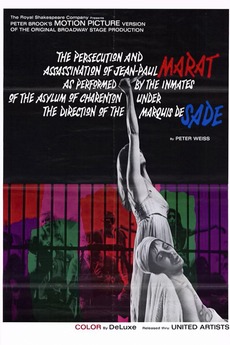 Peter Brook’s infamous filming of Peter Weiss’ MARAT/SADE is one of the screen’s great depictions of unfettered insanity, as well as a historical drama with definite contemporary relevance. About a play performed by maniacs under the direction of the notorious Marquis de Sade, it’s confrontational, provocative and stunningly filmed—in short, a classic.
Peter Brook’s infamous filming of Peter Weiss’ MARAT/SADE is one of the screen’s great depictions of unfettered insanity, as well as a historical drama with definite contemporary relevance. About a play performed by maniacs under the direction of the notorious Marquis de Sade, it’s confrontational, provocative and stunningly filmed—in short, a classic.
The Royal Shakespeare Company first performed Peter Weiss’ 1963 play THE PERSECUTION AND ASSASSINATION OF JEAN-PAUL MARAT AS PERFORMED BY THE INMATES OF THE ASYLUM OF CHARENTON UNDER THE DIRECTION OF THE MARQUIS DE SADE—invariably shortened to MARAT/SADE—under the direction of Peter Brook on Broadway in 1965. The production, set in the early 19th Century during Sade’s final years spent in the Charenton asylum, was a Tony Award winning success. This film version, directed by Brook and starring the Royal Shakespeare Company, was released in 1967.
Critics were initially unresponsive to the film, claiming Brook ruined his distinctive circus-like staging with close-ups and cutaways. Still, the film was staggeringly influential. It provided a conceptual blueprint for subsequent plays and movies about Sade, which like this one are largely set during Sade’s final years (see MARQUIS, SADE and QUILLS). None, however, have come close to equaling the propulsive intellectual power of MARAT/SADE.
In France of 1808 an audience of cultured Parisians have gathered (as French folk actually did back then) to view a play put on by the inmates of the Charenton asylum. The director is one of those inmates, the oft-banned writer Marquis de Sade (who actually served as the asylum’s entertainment director). The subject is the famed journalist Jean-Paul Marat, a central figure of the Reign of Terror that followed the French revolution, and his 1793 murder by Charlotte Corday. The killing took place in Marat’s bathtub, where he was confined due to a debilitating skin condition.
Sade’s play is situated around Marat in his bath, with performers periodically emerging from and disappearing into underground chambers situated in a circle around the tub. The play, intended as a simple depiction of Marat’s execution, quickly degenerates into a chaotic and unwieldy affair.
Marat’s political oratories are periodically interrupted by Sade, who has his own take on the ideals of the French revolution. He feels individuals should look out for themselves, in defiance of Marat’s staunch collectivism. (Those opposing viewpoints were obviously quite relevant during the sixties, the time of MARAT/SADE’S inception, and remain so today.)
Further interruptions issue from the ultraconservative head of the asylum, who constantly threatens to halt the performance. There’s also the problem of the crazy performers’ various afflictions: the woman who plays Corday is narcoleptic and constantly falling asleep on her feet, while a supporting player can’t keep from manhandling the women. Eventually madness overwhelms the performers, and the stage is engulfed in complete chaos.
There exists no other movie quite like this one. As he did in LORD OF THE FLIES and KING LEAR, with MARAT-SADE Peter Brook has nearly created an “anti-movie.” Slickness and craftsmanship are completely absent in Brook’s free-form juxtaposition of wide shots and extreme close-ups, filmed through shifty handheld camerawork. Most controversial are the impressionistic moments, such as the nightmare sequence depicted via out-of-focus silhouettes, that break the otherwise staunchly naturalistic veneer. I’m not bothered by such scenes, as they contribute immeasurably to the overall atmosphere of barely contained hysteria.
That hysteria boils over completely in the final scenes, an awe-inspiring cavalcade of mayhem. I understand it was mind-blowing to be present during the original Broadway performance of those final moments. Obviously nothing in this film can come close to matching that experience, but the brilliance and conviction of Brook’s staging is undeniable.
There are moments of impudence (the “general copulation” music number), sheer weirdness (Sade flogged by a woman’s hair) and bone-chilling eeriness (the aforementioned nightmare sequence), and even some memorable tunes (“15 Glorious Years” in particular). The performances of the Royal Shakespeare Company, playing crazy people impersonating actors, are simply brilliant, with standouts being a debuting Glenda Jackson as the narcoleptic playing Corday and an even more grandiose than usual Patrick Magee as the Marquis de Sade. There exist quite a few movies about the “Divine Marquis,” but MARAT/SADE is without question the one to see.
Vital Statistics
MARAT/SADE (THE PERSECUTION AND ASSASSINATION OF JEAN-PAUL MARAT AS PERFORMED BY THE INMATES OF THE ASYLUM OF CHARENTON UNDER THE DIRECTION OF THE MARQUIS DE SADE)
The Royal Shakespeare Company/Metro Goldwyn Meyer
Director: Peter Brook
Producer: Michael Birkett
Screenplay: Adrian Mitchell
(Based on the play by Peter Weiss)
Cinematography: David Watkin
Editing: Tom Priestley
Cast: Patrick Magee, Ian Richardson, Michael Williams, Clifford Rose, Glenda Jackson, Freddie Jones, Hugh Sullivan, John Hussey, William Morgan Sheppard, Jonathan Burn, Jeanette Landis
